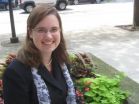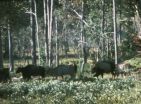(Press-News.org) Windows to the past, stars can unveil the history of our universe, currently estimated to be 14 billion years old. The farther away the star, the older it is — and the oldest stars are the most difficult to detect. Current telescopes can only see galaxies about 700 million years old, and only when the galaxy is unusually large or as the result of a big event like a stellar explosion.
Now, an international team of scientists led by researchers at Tel Aviv University have developed a method for detecting galaxies of stars that formed when the universe was in its infancy, during the first 180 million years of its existence. The method is able to observe stars that were previously believed too old to find, says Prof. Rennan Barkana of TAU's School of Physics and Astronomy.
Published in the journal Nature, the researchers' method uses radio telescopes to seek out radio waves emitted by hydrogen atoms, which were abundant in the early days of the universe. Emitting waves measuring about eight inches (21 centimeters) long, the atoms reflect the radiation of the stars, making their emission detectable by radio telescopes, explains Prof. Barkana. This development opens the way to learning more about the universe's oldest galaxies.
Reading signals from the past
According to Prof. Barkana, these waves show a specific pattern in the sky, a clear signature of the early galaxies, which were one-millionth the size of galaxies today. Differences in the motion of dark matter and gas from the early period of the universe, which affect the formation of stars, produce a specific fluctuation pattern that makes it much easier to distinguish these early waves from bright local radio emissions.
The intensity of waves from this early era depends on the temperature of the gas, allowing researchers to begin to piece together a rough map of the galaxies in an area of the sky. If the gas is very hot, it means that there are many stars there; if cooler, there are fewer stars, explains Prof. Barkana.
These initial steps into the mysterious origins of the universe will allow radio astronomers to reconstruct for the first time what the early universe looked like, specifically in terms of the distribution of stars and galaxies across the sky, he believes.
A new era
This field of astronomical research, now being called "21-centimeter cosmology," is just getting underway. Five different international collaborations are building radio telescopes to detect these types of emissions, currently focusing on the era around 500 million years after the Big Bang. Equipment can also be specifically designed for detecting signals from the earlier eras, says Prof. Barkana. He hopes that this area of research will illuminate the enigmatic period between the birth of the universe and modern times, and allow for the opportunity to test predictions about the early days of the universe.
"We know a lot about the pristine universe, and we know a lot about the universe today. There is an unknown era in between when there was hot gas and the first formation of stars. Now, we are going into this era and into the unknown," says Prof. Barkana. He expects surprises along the way, for example involving the properties of early stars, and that observations will reveal a more complicated cosmological reality than was predicted by their models.
INFORMATION:
American Friends of Tel Aviv University (www.aftau.org) supports Israel's leading, most comprehensive and most sought-after center of higher learning. Independently ranked 94th among the world's top universities for the impact of its research, TAU's innovations and discoveries are cited more often by the global scientific community than all but 10 other universities.
Internationally recognized for the scope and groundbreaking nature of its research and scholarship, Tel Aviv University consistently produces work with profound implications for the future.
Seeing the birth of the universe in an atom of hydrogen
Tel Aviv University uses radio waves to uncover oldest galaxies yet
2012-09-06
ELSE PRESS RELEASES FROM THIS DATE:
Genome-wide scan maps mutations in deadly lung cancers; reveals embryonic gene link
2012-09-06
Scientists have completed a comprehensive map of genetic mutations linked to an aggressive and lethal type of lung cancer.
Among the errors found in small cell lung cancers, the team of scientists, including those at the Johns Hopkins Kimmel Cancer Center, found an alteration in a gene called SOX2 associated with early embryonic development.
"Small cell lung cancers are very aggressive. Most are found late, when the cancer has spread and typical survival is less than a year after diagnosis," says Charles Rudin, M.D., Ph.D., professor of oncology at the Johns Hopkins ...
Hospital-acquired UTIs rarely reported in data used to implement penalties
2012-09-06
ANN ARBOR, Mich. — Aiming to cut expenses and improve care, a 2008 Medicare policy stopped paying hospitals extra to treat some preventable, hospital-acquired conditions – including urinary tract infections (UTIs) in patients after bladder catheters are placed.
But a statewide analysis by the University of Michigan shows there was very little change in hospital payment due to removing pay for hospital-acquired catheter-associated UTIs. For all adult hospital stays in Michigan in 2009, eliminating payment for this infection decreased hospital pay for only 25 hospital ...
LEDs winning light race to save energy, the environment
2012-09-06
RICHLAND, Wash. – Today's light-emitting diode light bulbs have a slight environmental edge over compact fluorescent lamps. And that gap is expected to grow significantly as technology and manufacturing methods improve in the next five years, according to a new report from the Department of Energy's Pacific Northwest National Laboratory and UK-based N14 Energy Limited.
"The light-emitting diode lamp is a rapidly evolving technology that, while already energy efficient, will become even more so in just a few short years," said Marc Ledbetter, who manages PNNL's solid-state ...
Exceptional upward mobility in the US is a myth, international studies show
2012-09-06
ANN ARBOR, Mich.—The rhetoric is relentless: America is a place of unparalleled opportunity, where hard work and determination can propel a child out of humble beginnings into the White House, or at least a mansion on a hill.
But the reality is very different, according to a University of Michigan researcher who is studying inequality across generations around the world.
"Especially in the United States, people underestimate the extent to which your destiny is linked to your background. Research shows that it's really a myth that the U.S. is a land of exceptional social ...
Wildlife Conservation Society releases list of Asian species at the conservation crossroads
2012-09-06
JEJU, SOUTH KOREA (September 5, 2012) — Will the tiger go the way of the passenger pigeon or be saved from extinction like the American bison?
The Wildlife Conservation Society (WCS) today released a list of Asian species that are at a conservation crossroads calling for governments to take immediate action with The Three R's Approach: Recognition, Responsibility, Recovery.
The list includes: the tiger, orangutans, Mekong giant catfish, Asian rhinos, Asian giant river turtles, and Asian vultures. The announcement was made at the IUCN's World Conservation Congress convening ...
Guys, take note: Male birth control pill may be ready soon, says Texas A&M professor
2012-09-06
Attention men: The day may be coming soon when you can take your own birth control pill with no side effects, according to a study done by a group of scientists that includes a Texas A&M University researcher.
Qinglei Li, an assistant professor in Texas A&M's College of Veterinary Medicine & Biomedical Sciences, is part of a team of researchers led by Martin Matzuk at Baylor College of Medicine and James Bradner at Dana-Farber Cancer Institute who made the discovery, and their work is published in the journal Cell.
Working on mice, the team found that a compound called ...
Major advances in understanding the regulation and organization of the human genome
2012-09-06
The National Human Genome Research Institute today announced the results of a five-year international study of the regulation and organization of the human genome. The project is named ENCODE, which stands for the Encyclopedia of DNA Elements. In conjunction with the release of those results, the Journal of Biological Chemistry has published a series of reviews that focus on several aspects of the findings.
"The ENCODE project not only generated an enormous body of data about our genome, but it also analyzed many issues to better understand how the genome functions in ...
Dinosaur die-out might have been second of 2 closely timed extinctions
2012-09-06
The most-studied mass extinction in Earth history happened 65 million years ago and is widely thought to have wiped out the dinosaurs. New University of Washington research indicates that a separate extinction came shortly before that, triggered by volcanic eruptions that warmed the planet and killed life on the ocean floor.
The well-known second event is believed to have been triggered by an asteroid at least 6 miles in diameter slamming into Mexico's Yucatán Peninsula. But new evidence shows that by the time of the asteroid impact, life on the seafloor – mostly species ...
Social exclusion on the playground
2012-09-06
Montreal, September 5, 2012 – Being the last one picked for the team, getting left out of the clique of cool girls, having no one to sit with at lunch… For children, social exclusion can impact everything from emotional well being to academic achievements.
But what does it mean for the kids doing the excluding? Is the cure a one-size-fits-all approach that requires kids to include others, regardless of the situation at hand? Not necessarily, says new research from a professor now at Concordia University.
Unlike previous studies where researchers created hypothetical ...
Researchers identify biochemical functions for most of the human genome
2012-09-06
CAMBRIDGE, MA -- Only about 1 percent of the human genome contains gene regions that code for proteins, raising the question of what the rest of the DNA is doing. Scientists have now begun to discover the answer: About 80 percent of the genome is biochemically active, and likely involved in regulating the expression of nearby genes, according to a study from a large international team of researchers.
The consortium, known as ENCODE (which stands for "Encyclopedia of DNA Elements"), includes hundreds of scientists from several dozen labs around the world. Using genetic ...
LAST 30 PRESS RELEASES:
Gut health à la CAR T
Dr. Pengfei Liu receives 2026 O'Donnell Award in Medicine for pioneering advances in genetic diagnostics and rare disease treatment
Dr. Yunsun Nam receives 2026 O'Donnell Award in Biological Sciences for pioneering RNA research transforming gene regulation and cancer therapy
Dr. Bilal Akin wins 2026 O'Donnell Award in Engineering for transformative work in EV energy systems and industrial automation
Dr. Fan Zhang receives 2026 O'Donnell Award in Physical Sciences for groundbreaking discoveries in quantum matter and topological physics
Dr. Yue Hu receives 2026 O'Donnell Award for revolutionizing energy operations with real-time AI and reinforcement learning
Greater risk that the political right falls for conspiracy theories
JMC Publication: Insilico’s AI platforms enable discovery of potent, selective, oral DGKα inhibitor to overcome checkpoint resistance
Targeting collagen signaling boosts drug delivery in pancreatic cancer
Valvular heart disease is common in cancer patients but interventions improve survival
When socially responsible investing backfires
Cuffless blood pressure technologies in wearable devices show promise to transform care
AI-based tool predicts future cardiovascular events in patients with angina
Researchers map how the cerebellum builds its connections with the rest of the brain during early development
Routine scans could detect early prostate radiotherapy changes
Fairness in AI: Study shows central role of human decision-making
Pandemic ‘beneath the surface’ has been quietly wiping out sea urchins around the world
Tea linked to stronger bones in older women, while coffee may pose risks
School feeding programs lead to modest but meaningful results
Researchers develop AI Tool to identify undiagnosed Alzheimer's cases while reducing disparities
Seaweed based carbon catalyst offers metal free solution for removing antibiotics from water
Simple organic additive supercharges UV treatment of “forever chemical” PFOA
£13m NHS bill for ‘mismanagement’ of menstrual bleeds
The Lancet Psychiatry: Slow tapering plus therapy most effective strategy for stopping antidepressants, finds major meta-analysis
Body image issues in adolescence linked to depression in adulthood
Child sexual exploitation and abuse online surges amid rapid tech change; new tool for preventing abuse unveiled for path forward
Dragon-slaying saints performed green-fingered medieval miracles, new study reveals
New research identifies shared genetic factors between addiction and educational attainment
Epilepsy can lead to earlier deaths in people with intellectual disabilities, study shows
Global study suggests the underlying problems of ECT patients are often ignored
[Press-News.org] Seeing the birth of the universe in an atom of hydrogenTel Aviv University uses radio waves to uncover oldest galaxies yet




